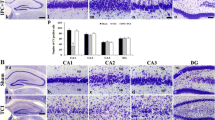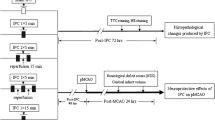The aim of the present work was to investigate the neuroprotective effects of early and late ischemic preconditioning (IPreC) in the acute phase of ischemic brain damage in rats. Single 5-min ischemic episodes of early IPreC were found not to produce significant neuroprotective effects as compared with controls, while three 5-min episodes of early IPreC led to significant increases in neurological deficit and increases in the level of neuron injury in hippocampal field CA1. Conversely, late IPreC, consisting of a single 5-min episode 24 h before modeling test ischemia, produced a significant neuroprotective effect, with decreased neurological deficit and retention of hippocampal field CA1 neuron viability.
Similar content being viewed by others
References
E. I. Gusev and V. I. Skvortsova, “Current concepts in the treatment of acute cerebral stroke,” Consilium Medicum, 2, No. 2, 60–65 (2000).
S. V. Ivanov, “Mental disorders associated with open heart surgery,” Psikhiatr. Pkikhofarmakol., 7, No. 3, 1–10 (2005).
S. V. Ivanov, A. L. Syrkin, and M. A. Samushiya, “Personality disorders in the post-operative period following aortocoronary shunting,” Zh. Nevrol. Psikhiat., 104, No. 12, 10–17 (2004).
N. S. Shcherbak and M. M. Galagudza, “Experimental models of ischemic stroke,” Byul. Tsentra Serd. Krovi, Endokrinol. im. V. A. Almazova, No. 3, 39–46 (2011).
N. S. Shcherbak, M. M. Galagudza, E. M. Nifontov, et al., “Effect of ischemic postconditioning in experimental global cerebral ischemia,” Arterial. Gipertenz., 17, No. 2, 182–188 (2011).
D. N. Atochin, J. Clark, I. T. Demchenko, et al., “Rapid cerebral ischemic preconditioning in mice deficient in endothelial and neuronal nitric oxide synthases,” Stroke, 34, No. 5, 1299–1303 (2003).
G. A. Donnan, M. Fisher, M. Macleod, and S. M. Davis, “Stroke,” Lancet, 371, 1612–1623 (2008).
E. Farkas, P. G. M. Luiten, and G. Bari, “Permanent, bilateral common carotid artery occlusion in the rat: A model for chronic cerebral hypoperfusion neurodegenerative diseases,” Brain Res. Rev., 54, 162–180 (2007).
M. E. Feder and G. E. Hofmann. “Heat-shock proteins, molecular chaperones, and the stress response: evolutionary and ecological physiology,” Annu. Rev. Physiol., 61, 243–282 (1999).
J. M. Gidday, “Cerebral preconditioning and ischaemic tolerance,” Nat. Rev. Neurosci., 7, 437–448 (2006).
A. R. Green, “Pharmacological approaches to acute ischaemic stroke: reperfusion certainly, neuroprotection possibly,” Br. J. Pharmacol., 153, S325–S338 (2008).
H. Kato, K. Kogure, and S. Nakano, “Neuronal damage following repeated ischemia in the gerbil,” Brain Res., 479, 366–370 (1989).
H. Kato, Y. Liu, T. Araki, and K. Kogure, “Temporal profile of the effects of pretreatment with brief cerebral ischemia on the neuronal damage following secondary ischemic insult in the gerbil: cumulative damage and protective effects,” Brain Res., 553, No. 2, 238–242 (1991).
T. Kirino, A. Tamura, and K. Sano, “A reversible type of neuronal injury following ischemia in the gerbil hippocampus,” Stroke, 17, 455–459 (1986).
K. Kitagawa, M. Matsumoto, M. Tagaya, et al., “‘Ischemic tolerance’ phenomenon found in the brain,” Brain Res., 528, No. 1, 21–24 (1990).
H. J. Lee, J. S. Kiang, and Y. I. Kim, “Citicoline protects against cognitive impairment in a rat model of chronic cerebral hypoperfusion,” J. Clin. Neurol., 5, 33–38 (2009).
C. P. McGraw, “Experimental cerebral infarction effects on pentobarbital in Mongolian gerbils,” Arch. Neurol., 34, 334–336 (1977).
J. Moncayo, G. R. de Freitas, J. Bogousslavsky, et al., “Do transient ischemic attacks have a neuroprotective effect?” Neurology, 54, 2089–2094 (2000).
C. E. Murry, R. B. Jennings, and K. A. Reimer, “Preconditioning with ischemia: a delay of lethal cell injury in ischemic myocardium,” Circulation, 74, No. 5, 1124–1136 (1986).
S. Nakano, H. Kato, and K. Kogure, “Neuronal damage in the rat hippocampus in a new model of repeated reversible cerebral ischemia,” Brain Res., 490, No. 1, 178–180 (1989).
T. P. Obrenovich, “Molecular physiology of preconditioninginduced brain tolerance to ischemia,” Physiol. Rev., 88, No. 1, 211–247 (2008).
K. Ohno, U. Ito, and Y. Inaba, “Regional cerebral blood flow and stroke index after left carotid artery ligation in the conscious gerbil,” Brain Res., 297, 151–157 (1984).
M. Ohno and S. Watanabe, “Ischemic tolerance to memory impairment associated with hippocampal neuronal damage after transient cerebral ischemia in rats,” Brain Res. Bull., 40, No. 3, 229–236 (1996).
S. Pasupathy and S. Homer-Vanniasinkam, “Surgical implications of ischemic preconditioning,” Arch. Surg., 140, 405–409 (2005).
G. Paxinos and C. Watson, The Rat Brain in Stereotaxic Coordinates, Academic Press, New York (1998).
P. Sandercock, E. Berge, M. Dennis, et al., “A systematic review of the effectiveness, cost-effectiveness and barriers to implementation of thrombolytic and neuroprotective therapy for acute ischaemic stroke in the NHS,” Health Technol. Assess., 6, No. 26, 1–112 (2002).
K. A. Sotaniemi, “Long-term neurologic outcome after cardiac operation,” Ann. Thorac. Surg., 59, No. 5, 1336–1339 (1995).
M. P. Spencer, “Transcranial Doppler monitoring and causes of stroke from carotid endarterectomy,” Stroke, 28, 685–691 (1997).
S. Tomida, T. S. Nowak, Jr., K. Vass, et al., “Experimental model for repetitive ischemic attacks in the gerbil: the cumulative effect of repeated ischemic insults,” J. Cereb. blood Flow Metab., 7, No. 6, 773–782 (1987).
Author information
Authors and Affiliations
Corresponding author
Additional information
Translated from Rossiiskii Fiziologicheskii Zhurnal imeni I. M. Sechenova, Vol. 98, No. 8, pp. 990–999, August, 2012.
Rights and permissions
About this article
Cite this article
Shcherbak, N.S., Vyboldina, T.Y., Galagudza, M.M. et al. Effects of Early and Late Ischemic Preconditioning of the Brain on the Severity of Hippocampal Neuron Injury and the Degree of Neurological Deficit in Rats. Neurosci Behav Physi 44, 415–420 (2014). https://doi.org/10.1007/s11055-014-9927-0
Received:
Published:
Issue Date:
DOI: https://doi.org/10.1007/s11055-014-9927-0




